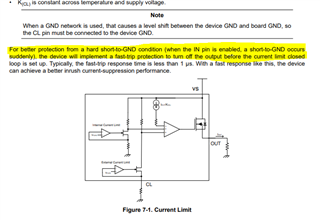Hi Experts,
TPS1H200A-Q1 is under evaluation on customer side. There are several issues occur on customer side, could you help on those issue? Thanks.
- When the device is Latch-off mode, when the overcurrent occurs, it takes tcl(deg)+tdl1+tdl2 to shut the output. When the overcurrent time is less than tcl(deg)+tdl1+tdl2, the output still work well and the fault is high. Is it normal? We didn’t see this scenario description in datasheet.
- Basing on the test result and understanding of scenario 1, we find that: when the overcurrent is occur, the overcurrent time is less than tcl(deg)+tdl1+tdl2 and bigger than tcl(deg), the fault will enter low level then go back to High level, then the overcurrent occur again in the middle of tcl(deg) ~ tcl(deg)+tdl1+tWe find that the fault go to low level and the OUT is down due to the fault low level. See the left picture below: CDelay=4.7uF. The tdl1+tdl2 is set to 2mS. Could you comment on this?
Best Regards
Songzhen Guo


